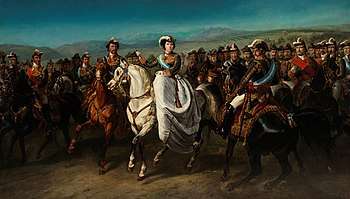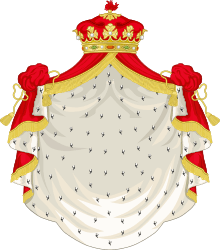Grandee
Grandee (/ɡrənˈdiː/; Spanish: Grande de España, Spanish: [ˈɡɾande]; Portuguese: Grande de Portugal, Portuguese: [ˈɡɾɐ̃dɨ]) is an official aristocratic title conferred on some Spanish nobility and Portuguese nobility. Holders of this dignity enjoyed similar privileges to those of the peerage of France during the Ancien Régime, though in neither country did they have the significant constitutional political role the House of Lords gave to the Peerage of England and later Peerage of the United Kingdom. In Spanish eyes, "Grandee of Spain" is the highest dignity of nobility in all of Europe, due to its privileges having been greater than those of other similar European dignities, such as the peers of France or the peers of Great Britain.[1]

All Spanish dukedoms are automatically attached to a Grandeeship yet only a few Marquessates, Countships, Viscountcies, Baronies and Lordships have the distinction. A single person can be a Grandee of Spain multiple times, as Grandeeships are attached, with the exception of a few cases, to a title and not an individual. Consequently, nobles in Spain with more than one title, most notably the Duchess of Medinaceli and the Duke of Alba, are Grandees 10 and 9 times respectively.
As of 2018, Grandeeships totalled 417 out of the 2,942 extant titles in Spain (approximately 14%) of which there were 153 Dukedoms, 142 Marquessates, 108 Countships, 2 Viscountcies, 2 Baronies, 3 Lordships and 7 hereditary yet non title-attached Grandees.[2] Despite losing their last legal privilege in 1984, when the right to possess diplomatic passports and immunity were revoked for all Grandees of Spain, they still enjoy certain ceremonial privileges.[3] All Grandees are entitled to remain covered in the presence of the King of Spain, as well as being addressed by him as primo (cousin), a privilege that originated in the 16th century, when most Grandees were close relatives of the Monarch.[4]
In addition, the term can refer to other people of a somewhat comparable, exalted position, roughly synonymous with magnate; formerly a rank of high nobility (especially when it carried the right to a parliamentary seat). By extension, the term can refer informally to any important person of high status, particularly wealthy, landed long-time residents in a region. In the United Kingdom the term is currently and informally used of influential and long-standing members of the Conservative Party, Labour Party and Liberal Democrats,[5][6] and has had more specific meanings in the past.
Spain

Most Spanish noble titles are granted as títulos del Reino (Peer of the realm), many of which predate the modern Spanish monarchy. The Kings of Spain re-established in 1520 the ancient dignity of Grande to confer as an additional rank of honour. The Post-nominals of Grandees of Spain is GE.[7][8]
The dignity of Grandee (Grand noble) began to be assumed by Spain's leading noblemen in the Middle Ages to distinguish them as a Grand señor ('Lord of the realm'), from lesser ricoshombres (Nobles de naturaleza), whose rank evolved into that of hidalgo. It was, as John Selden the 17th-century English jurist pointed out, not a general term denoting a class, but "an additional individual dignity not only to all Dukes but to some Marquesses and Counts also".[9][10] Noble titles, including and above the rank of Count, were seldom created in heredity by the Kings of Castile and Aragon until the late Middle Ages—in contrast to France and elsewhere in Europe (where feudalism evolved more quickly)—being largely associated with royal officers until the 14th century. The conferral of grandeeships initially conveyed only ceremonial privileges, such as remaining covered or seated in the presence of royalty. Over time grandees received more substantial rights: for example freedom from taxation and immunity from arrest, save at the King's command;[10] they were usually the senior judicial officers of their region. These rights later became open to abuse with some Grandees renouncing their allegiance to the monarchy to wage war on the King.
In the late 1470s, King Ferdinand II and Queen Isabella I were the first to clamp down on grandee powers assumed by the medieval territorial nobles. In the 16th century, limitations on the number of grandees were introduced by King Charles I (who later became Holy Roman Emperor as Charles V), who decreed that the Spanish Crown had the sole right to confer the dignity of a grandee.
Subsequently, the Grandes de España (Grandees of Spain) were subdivided into three grades:[10]
- those who spoke to the King and received his reply in full regalia;
- those who addressed the King uncovered, but by right wore their coronets to hear his answer;
- those who required permission from the King before wearing their coronets.[10]

All grandees traditionally have been addressed by the king as mi Primo (my cousin), whereas ordinary nobles are formally styled as mi Pariente (my kinsman). Grandezas could also be bestowed upon foreigners, such as the memorialist Louis de Rouvroy, Duc de Saint-Simon who took great pride in becoming a grandee after his successful posting as French Ambassador to Madrid, representing King Louis XIV.
The dignity of grandee was abolished by the Napoleonic King Joseph Bonaparte, before being revived in 1834 by Estatuto real when grandees were given precedence in the Chamber of Peers of Spain.
Nowadays, all grandees are deemed to be "of the first class", and is an honorific dignity conferring neither power or legal privilege. A Grandeza de España (grandeeship) is separate legal entity from a title of nobility, although grandezas are normally but not exclusively granted in conjunction with a title. Since the 20th century invariably the King of Spain has conferred a Grandeza de España upon any newly created duke.
A grandee of any noble rank is higher in precedence than a non-grandee (apart from members of the Spanish Royal Family), even if that non-grandee holds a hereditary title (titulo) of a higher grade than that of the said grandee. Thus, a baron-grandee would outrank a non-grandee marquess, thus rendering the dignity of grandeza an hereditary rank of precedence rather than a title of nobility. Since 1987, children of an infante of Spain are recognised as members of the Spanish royal family and are accorded the rank and style of a grandee by courtesy: they do not formally hold this dignity until such time as a title with grandeza is granted to them by the sovereign.[11]
Some of the best known Spanish grandees are the Dukes of Arcos, Dukes of Alba, of Medinaceli, of Villahermosa, of Osuna, del Infantado, of Alburquerque, of Moctezuma, of Nájera, of Frías and of Medina-Sidonia; well-known Marquesses include those of Aguilar de Campoo, of Astorga, of Santillana, and of los Vélez; the Counts of Benavente, Lerín, Olivares, Oñate, and Lemos also hold grandeeships.
Grandees and their consorts are entitled to the honorific prefix of 'the Most Excellent Lord/Lady' or 'His/Her Most Excellency', and they are addressed as Primo (cousin) by the King.
Portugal and Brazil
Both Portuguese and Brazilian nobility formerly used the term Grande ("grandee"), to designate a higher rank of noblemen. The Brazilian system, for instance, automatically deemed dukes, marquises and counts (as well as archbishops and bishops) Grandes do Império ("Grandees of the Empire", or literally translated as "Great Ones of the Empire"). Viscounts and barons could also be ennobled with or without grandeza ("grandeeship", alternatively "greatness").
Viscounts ennobled with grandeeship displayed a Count's coronet on their coat of arms, and Barons ennobled with grandeeship bore a coat of arms surmounted by a Viscount's coronet.
The order of precedence in Brazilian nobility was as follows: after the members of the Imperial Family, dukes, marquises, counts, viscounts with grandeeship, viscounts without grandeeship, barons with grandeeship, barons without grandeeship. Brazilian grandeeships, like its nobility, were not hereditary titles.
Grandees were allowed to keep their heads covered in the presence of the king or emperor until such time as the monarch may command otherwise; as elsewhere throughout Europe, these noble families displayed their coats of arms on their properties, carriages (or vehicles), and over their graves (see hatchment). The abolition of the monarchies in Portugal and Brazil extinguished the formal use of such titles, although their use continues among some of the Portuguese aristocracies.
Grandee (New Model Army)
During the English Civil War, senior military officers from the landed gentry serving in the New Model Army, opposing the Levellers, came to be informally termed Grandees.[12]
After the defeat of King Charles I in the civil war, there was a series of debates and confrontations between the radical elected representatives of the New Model Army soldiers, known as Agitators, and the Army Grandees such as Sir Thomas Fairfax, Oliver Cromwell, and Henry Ireton, who opposed the Agitators' more radical proposals. The disagreements were aired publicly at the Putney Debates, which started in late October 1647 and lasted for several weeks.[13]
References
- [Santa Cruz y Mallen, Francisco Javier: Origen y transformación de la Grandeza de España (1946).]
- "Diputación permanente y consejo de la grandeza de España: Title Guide". If one inputs the value grandeza de España in the GRANDEZA section of the title guide, it will return 417 results. If one further inputs Marques de, Conde de, Vizconde de, Baron de and Señor de it will return 142, 108, 2, 2 and 3 respectively. Furthermore, if one inputs Grande de España in the TITLE section, it will return 7 results, that is, the 7 Grandees not attached to titles.
- Bayón, Félix (28 May 1984). "Cardenales, ex ministros y grandes de España, privados del pasaporte diplomático" [Cardinals, ex-ministers and Grandees of Spain, deprived of Diplomatic Passports]. El País (in Spanish).
- Quintanilla Raso, María Concepción (2006). Títulos, grandes del reino y grandeza en la sociedad política: Fundamentos en la Castilla medieval [Titles, Royal Grandees and Grandeeship in Political Society: Fundamentals in Medieval Castile]. p. 99.
- Hughes, David (12 August 2009). "Another Tory grandee quits the Commons". The Independent.
- "'Young' Bercow mocks Tory grandee". BBC News Online. 22 June 2009.
- Elenco de Grandezas y Títulos Nobiliarios Españoles. Real Asociación de Hidalgos de España. pp. 1–5.
- Soler Salcedo, Juan Miguel. Nobleza española. p. 150.
- Titles of Honor, ed. 1672, p. 478
- Chisholm, Hugh, ed. (1911). . Encyclopædia Britannica. 12 (11th ed.). Cambridge University Press. p. 349.
- "Spanish Royal Decree 1368/1987: Regulation of Titles, Styles and Honors of the Royal Family". Boletín Oficial del Estado. Retrieved August 14, 2010.
- The OED first cites this specific usage as "1648–9 C. WALKER Relat. & Observ. 1 The said Leading men or Grandees (for that is now Parliament language) First divided themselves into two factions."
- David Plant The Levellers on the website of the British Civil Wars and Commonwealth